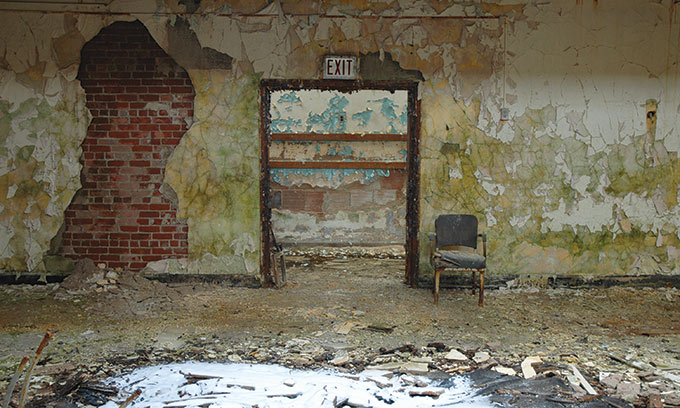Mainly a Question of Visions, The Pictures
by Woody Brown

Abandoned Asylums of New England
by John Gray and the Museum of disABILITY History
People Ink Press, 2012
The Museum of disABILITY History, a project of People Inc. “dedicated to advancing the understanding, acceptance and independence of people with disabilities,” has released Abandoned Asylums of New England, a beautiful collection of photographs of derelict mental hospitals by talented photographer John Gray. The book is the latest publication in the Abandoned History Series from People Ink Press, which, as you might have guessed, is People Inc.’s press. The museum says the goal of Abandoned Asylums is to assist in the preservation of “records and memories related to the care and treatment of the poor, sick, and disabled,” and this stunning, informative book certainly achieves that.
Abandoned Asylums comprises a brief introduction of the history of the architecture of asylums and photographic profiles of twelve hospitals and schools, none of which are currently in operation and most of which have been demolished. The names of the institutions alone (e.g. Belchertown State School for the Feeble-Minded) give an impression of the radical evolution of social attitudes toward mental illness and disability that has occurred since the Civil War. Summaries of the history of each institution begin the chapters, the purview of which is sufficiently wide but concise enough to inspire further research. The museum clearly anticipated this and made the smart decision to include citations and URLs for relevant primary sources in the book’s appendix. (For anyone interested in mental illness and the conditions of asylums in the 19th and 20th centuries, I would suggest you read Daniel Paul Schreber’s Memoirs of My Nervous Illness (1903), from which the title this article is taken: “Another consideration is that it is mainly a question of visions, the pictures of which I have in my head, but the description of which in words is extremely difficult, in part absolutely impossible.”)

Many of the institutions profiled in Abandoned Asylums were sites of horrific abuse and mistreatment, some of which was antiquated standard practice. Most of the crimes (which might be lightly termed human rights violations), however, were the logical result of a perfect storm of several coincident factors, including but not limited to systematic underfunding, the popularity of brutal, ham-fisted treatment methodologies, and a deep and cruel social belief in the moral deficiency of the ill. This final factor is one of the most interesting to me because it suggests a reading of illness that considers more than biology, a reading that nowadays is verboten to say the least. Prejudicial treatment of the mentally ill and disabled is widespread and much maligned, but this does not seem to accord with the loudly professed American commitment to Big Pharma, the soul-crushing mantra of which we can locate in the slogan for EPIDUO Gel: “Blame biology!”
Gray’s photographs of these decrepit buildings, most of which are gutted and empty, stage the invisible histories of the now departed residents. In that sense, they perform an invaluable service. But they are also wonderful to look at apart from the Museum’s laudable social agenda. Gray’s work is happily devoid of high-dynamic-range (HDR) imaging, a technique very much in vogue now, especially in pictures of abandoned buildings, that involves the combination of several images, each with a different exposure value, to resolve detail in areas of an image that would otherwise be too light or too dark. This produces images that tend to have an otherworldly glow to them, almost as if they are not photographs but very detailed computer renderings. Gray instead allows the frank, brutal beauty of the spaces that are the subjects of his photographs to shine with minimal obvious modification beyond framing.
Abandoned Asylums is large, informative, and ideal both for relaxed perusal and research. It will prove interested to both the uninformed reader and the curious professional. Most of all, the work that Gray and the Museum of disABILITY History have compiled does its part to assure that the stories of this marginalized group are not lost irretrievably.
The Museum of disABILITY History is located at 3826 Main Street in Buffalo, just north of Bailey, and is open to the public six days a week. Abandoned Asylums is available for purchase there and at Talking Leaves.
blog comments powered by Disqus
|
Issue Navigation> Issue Index > v12n14 (Week of Thursday, April 4) > Mainly a Question of Visions, The Pictures This Week's Issue • Artvoice Daily • Artvoice TV • Events Calendar • Classifieds |









 Current Issue
Current Issue